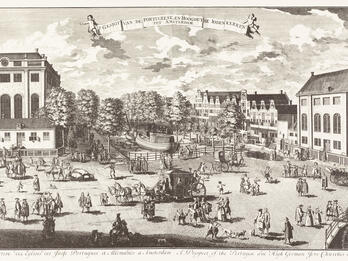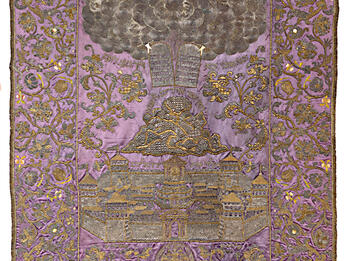Narraçāo da vinda dos Judeos espanhões a Amsterdam (Account of the Coming of the Spanish Jews to Amsterdam)
The illustrious gentlemen, ḥakham R. Mosseh Ury ha-Levi (of blessed memory) and his son, R. Aaron Ury ha-Levi, my father and master: both were residents of Emden, in the province of Oost-Friesland, and had written over the door of their house, emet ve-shalom yesod ha-‘olam, which means, “Truth and peace are the foundation of the world,” and below, its translation in the Latin language.
It so happened that in the year 5364 [1604], two ships coming from Spain arrived in this city, bearing ten Jews from Spain (namely, forced [converts to Christianity]) and four boys, loaded with merchandise, furniture, and household utensils, amounting to much capital. When some of those Jews, or passengers of the ships, came ashore and strolled through the city, they saw a decapitated duck being taken to the house of my grandfather, and noticed that the motto was in Hebrew characters, which they did not know how to read. When these aforementioned merchants arrived at their lodging, they said to the innkeeper that they wanted to dine that day on duck. The innkeeper went to buy one and, upon entering my grandfather’s house, he saw a very fat decapitated duck on the table there, and, seeking to purchase the said duck, he recounted that some rich merchants had arrived from Spain and were very desirous of eating a fat duck. My grandfather said he was sorry but he had had that duck slaughtered for himself. Since the innkeeper pleaded and pleaded that he sell it to him, he gave him the duck on the condition that, in return, he would give him another duck in the same state as the other one. The innkeeper went home very happy with the duck, and when he showed it to his Jewish guests, they said that it was so fat that they could not eat it. When they asked him where he had bought it, he replied that he had purchased it from the Jew. They said (in amazement, being forced converts), perchance there are Jews here! There are Jews here! The Christian said that there were and that they had a motto in Hebrew on their door.
The following day, two of these passengers went to the house of my grandfather (who is with God) and, since they spoke to him in Spanish, he could not understand them and he called his son Aharon [Aaron], who was my father (who basks in the glory [of God]) to speak with them and they told him they wanted to speak with him in secret. After they all entered a privy, they spoke openly with my father, saying that they had arrived there with two ships that had left Spain; that, from among all the passengers, they were ten merchants and four boys, and that they wished to become circumcised because they were descended from the children of Israel. My father replied to them that this could not be performed in that city because they were all Lutherans, observing the religion of Luther. Nevertheless, he would show them a panel that he had in his house, on which the city of Amsterdam was painted and that he would show them the painting—a tower called Montelbaanstoren. And that when they reached that city, they should rent a house in Jonkerstraat, in front of the aforenamed tower and should make an insignia so that they [my father and grandfather] would be able to recognize and find the house, for they would arrive there in two or three weeks’ time. Thus, they left for Amsterdam and rented a house where he told them to, in front of the tower, that the Portuguese still call the Tower of Aaron. Thus, my grandfather and my father (may God protect him) went to Amsterdam to visit these gentlemen and found them on the street with the insignia, as they had told them. When they arrived, the merchants rejoiced and my grandfather and father circumcised all ten merchants and four boys. They rented a room where they conducted their prayers every day, with great devotion and reverence.
After some weeks had elapsed, the Christian neighbors denounced them to the authorities, saying that there were people from Spain living there who had allowed themselves to be circumcised by two foreign Jews and had conducted daily prayers in a separate room. When the burgomasters heard this, they ordered that my grandfather and my father be arrested for having committed these acts, and after being detained for a few days, they were brought before the burgomasters and questioned: Who gave them the authority to conduct a new religion of Jews here and circumcise these people who had come from Spain? You people deserve to be put to death. My father and grandfather replied to the burgomasters: What we did was correct, but it was done for the boon and benefit of the city of Amsterdam, to have it enter upon a great business venture, for we could well have done this elsewhere, where we would have been accorded complete freedom. However, we did it so that this city could embark upon great business ventures by sea, because these people from Spain have brought great capital and wealth with them. And if you feel you would be well served by giving these people from Spain the freedom to be able to live here freely, we assure you, Sir Burgomasters, that in a year’s time, you will have here more than fifty families of this nation from Spain and Portugal, with great capital, and they will place this city of Amsterdam at the business forefront of all other places in Europe (because, before this, Amsterdam was engaged in few business dealings). When the burgomasters heard this from my grandfather and father, they asked: Where do these people reside? They replied: In the house where you ordered us to be arrested. They promptly had them called before the burgomasters and when the people from Spain came before them, they knew how to speak only Spanish or Latin. Thus, the burgomasters began to speak to them in Latin and, examining them, they found that it was all true, just as my father and grandfather had said—that in a short time, after giving them their freedom, many of the leading families of Spain and Portugal would come, with great capital. When the burgomasters heard this, they were overjoyed and sent them home.
After this, the burgomasters sent for my grandfather and my father (may God protect him) and said: Your words about the people from Spain concur with the facts. For this reason, we have decided to give you all the freedom in the world to live here and freely observe your law and religion as well as a house to conduct your prayers. Upon hearing this, my father and grandfather profusely thanked the burgomasters and went home joyously and brought this good news to the Jews of Spain, who embraced them and cried with joy, praising the Blessed Lord for the favor he had accorded them. Thus, they wrote to Spain and Portugal about the freedom that the burgomasters of Amsterdam had given them. Afterwards, many families came from Spain and Portugal to live here in this city, and my grandfather became their ḥakham and my father became their cantor, and they circumcised them and were the founders of this congregation. And he codified the prayers as well as the laws and regulations of the congregation, according to how they should observe the precepts of the Blessed God. May their numbers, through His mercy, increase forever. Amen.
And when the Jews of Germany and Poland heard that Jews from Spain and Portugal were living here, they also came to live here and have assumed complete authority until this very day. May the Lord be praised for all the many favors that He has done for us and may He bring us closer to our ultimate reward, with the coming of our messiah, amen.
Credits
Uri de Aharon ha-Levi, Narração da vinda dos Judeos espanhões a Amsterdam (Account of the Coming of the Spanish Jews to Amsterdam), trans. Mosseh Levy Maduro (Amsterdam: Na officina typographica de G. J. Janson, 1768; facsimile repr., Amsterdam, 1933), pp. 2–7.
Published in: The Posen Library of Jewish Culture and Civilization, vol. 5.







